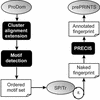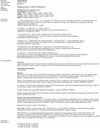PRINTS and its automatic supplement, prePRINTS
- PMID: 12520033
- PMCID: PMC165477
- DOI: 10.1093/nar/gkg030
PRINTS and its automatic supplement, prePRINTS
Abstract
The PRINTS database houses a collection of protein fingerprints. These may be used to assign uncharacterised sequences to known families and hence to infer tentative functions. The September 2002 release (version 36.0) includes 1800 fingerprints, encoding approximately 11 000 motifs, covering a range of globular and membrane proteins, modular polypeptides and so on. In addition to its continued steady growth, we report here the development of an automatic supplement, prePRINTS, designed to increase the coverage of the resource and reduce some of the manual burdens inherent in its maintenance. The databases are accessible for interrogation and searching at http://www.bioinf.man.ac.uk/dbbrowser/PRINTS/.
Figures


References
Publication types
MeSH terms
Substances
LinkOut - more resources
Full Text Sources
Other Literature Sources

